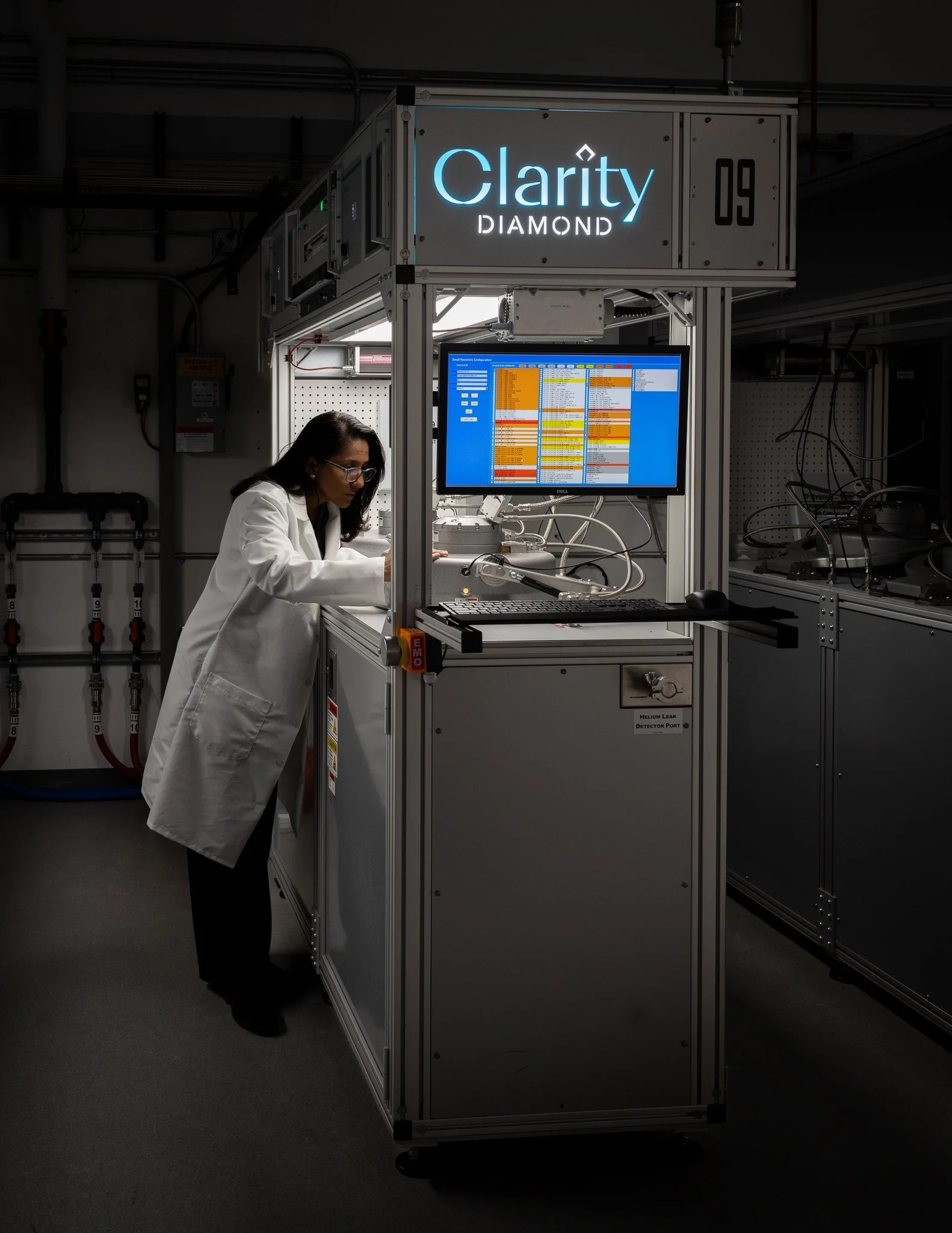From The Source: A Deep-Dive into the Inimitable Diamond with Amanda Charris, Director of Process Technology at Plasmability
The invention of lab-created diamonds and their subsequent development into gem-quality works of art shook the world of fine jewelry perhaps more than any other technological development in history. Of course, it isn’t the only technology to impact fine jewelry trends and demand: the sophistication of modern diamond cuts is made possible by laser technology; the use of platinum is made possible by extreme-temperature fires; the development of CAD-cast jewelry has made creative design more accessible to buyers. But lab-created diamonds offer a complete shift of price points and access that has redefined what the definition of “fine jewelry” is. With mass-market options available to consumers at a fraction of the cost of comparable natural options, buyers might rightly wonder what even makes a diamond special anymore. For that, we decided to go to the source: meet Amanda Charris, Director of Process Technology at Plasmability, a leader in the lab diamond development space and our expert on what makes this material so compelling. Plasmability produces gem-quality diamonds in Austin, Texas for Clarity, our preferred lab-diamond maker.
Meaghan: Amanda, thank you for taking the time to speak with me today, we are so excited to introduce you to our clients. Your work with Clarity has really blown me away and I’m sure our clients will appreciate hearing about the nuts and bolts of lab diamond development.
Amanda: Happy to be here.
Meaghan: To start, can you tell us a bit about yourself: your professional background, education, and what you do on a day-to-day basis?
Amanda: Sure, I have a master's degree in solid state physics and I completed my Ph.D. in electrical engineering. I am the Director of Process Technology at Plasmability, and I guess I would say my daily responsibilities include overseeing and leading all production of diamond-based materials for gems, electrical, and semiconductor applications. I manage a foundry in Austin, Texas with about 20 production chambers running constantly and two research systems for new product development.
Day-to-day, I lead a multi-skilled group of technicians and engineers to continuously improve our products. I would say that problem-solving is a key part of my role, including improving products, fixing system issues, addressing recipe failures, and optimizing yield (the ratio of finished carats to starting carats).
Amanda in her lab:
“Behind the "forever" durability is the amazing rarity and perfection of that structure, and the fact that humans have the ability to grow diamonds, which gives society power and responsibility to explore, question, and keep looking for new applications is really incredible, I think. For me, diamond creates a feeling of wanting to know more.”
Meaghan: Do you exclusively work with diamonds for gems, or do you also develop diamond material for other applications?
Amanda: Oh, I work with other applications as well. Diamond is an incredibly useful material. I work with diamond development for semiconductor and electrical applications, which can be done due to their amazing thermal conductivity. Because we have gotten so good at controlling impurities in the material we develop, this allows diamonds to be used for various optical applications that we’re constantly finding more uses for.
Meaghan: Tell me a bit about what the historical uses of diamond material has looked like, separate from their gem qualities.
Amanda: Diamond material has extraordinary properties due to its atomic structure. It is the hardest material on earth, which allowed it to be first used in the mechanical industry for drilling and breaking various materials. Additionally, it has amazing thermal conductivity so it is used in electronic devices to dissipate heat. It exhibits unique optical and electrical behavior - optically through emissivity and reflection, creating perfect transparency with proper crystalline structure.
Meaghan: Sure, this perfect transparency is something that the average consumer can begin to grasp when looking at a cut diamond under a loupe. It’s fascinating that this also translates into unique scientific applications.
Amanda: Yes, and the combined optical properties and hardness make it ideal for optical windows in aerospace and semiconductor industries.
View of Plasmability’s Austin, Texas foundry
Meaghan: When you say semiconductor applications, what does that look like for someone who doesn't know much about this niche technology?
Amanda: Of course. One thing to understand is that electrically, an undoped diamond (pure carbon in the correct atomic formation) is an insulator like glass, but when deliberately doped with impurities (boron, phosphorus, nitrogen), it becomes a P-type or N-type semiconductor. As a semiconductor, diamond outperforms any other semiconductor currently on the market, with a higher electric breakdown voltage than silicon carbide (which is used in current chips). The current chip limitation is heat generation - more power and transistors create more heat that needs faster dissipation. As you can imagine, this requires huge cooling systems for small chips, which renders them difficult to apply to more uses. Diamond's superior heat dissipation properties offer tremendous advantages, though scaling and reproduction remain challenging.
Meaghan: Is the newer side of diamond applications in industrial use due to how pure we can now make synthetic materials?
Amanda: Yes, this is correct. The first lab-grown diamond creation spread in the scientific community in 1952 and was initially used for hardness applications to help humanity. Man-made processes changed the paradigm in that the material could be cheaper and benefit more companies and society. As technology improved and techniques advanced, the ability to grow better diamonds, control impurities, and improve material quality increased and scientists began exploring additional applications beyond mechanical uses. Optical applications emerged due to diamond's spectacular material properties combined with hardness and durability, and research continues advancing in electrical, semiconductor, and quantum applications. Groups worldwide (US, UK, Asia) work on growing materials to solve society problems and advance technology. I truly believe that this research and advancement will continue indefinitely.
How Clarity Lab-Created Diamonds Are Made
Graphic Source: Clarity Diamonds





Meaghan: Unlike other gemstones that are composed of elemental composites, diamond is a single element material. Can you elaborate on what makes this special?
Amanda: Diamond is the only gemstone made of a single element, while sapphire, emerald, and rubies are made with 2-4 different components. Diamond consists of carbon atoms strategically arranged in a perfect crystal structure with unique bonding, specific distances between atoms, and FCC (face-centered cubic) structure with four atoms inside a 3D cube. This arrangement creates hardness, amazing optical properties, and spectacular thermal management from the material itself (without doping). Of course, this allows diamond material to be scientifically spectacular, but these same qualities also translate to high desirability from an aesthetic perspective as well. Diamonds can be cut and polished perfectly to reflect 100% of light, the hardness is unmatched for jewelry wear, and you can achieve these beautiful cuts due to the material composition. This is why I have always been fascinated with diamonds as a unique material serving humanity in so many ways.
Meaghan: Tell me a bit more about that. What drew you to specializing in this particular field of research?
Amanda: When I was young, I really viewed diamonds as luxury items associated with sophistication and models and royalty. Diamonds felt unaffordable and untouchable for middle class people and I had very little opportunity to interact with them, but I was always fascinated by their beauty. When I started working with diamonds in my research, it was initially for scientific applications like electronic devices, diodes, transistors, rather than gemstones, which fully immersed me in their incredible material qualities. When the opportunity arose to work with Plasmability, I felt like I found my purpose: making diamonds accessible to people who previously saw them as luxury items, like myself. I could combine this fascination I always had with the beauty of diamond with the science I had learned to use. I wanted mothers to afford diamond rings for quinceañeras or graduation necklaces for daughters. My goal is to provide the best quality diamonds parallel to mined diamonds - chemically and structurally identical - that would combine my appreciation for the beauty of diamonds with the material superiority of diamond material.
Meaghan: Let’s talk about the saying “diamonds are forever”. Everyone knows it, everyone believes it. What is behind this?
Amanda: Yes, De Beers certainly found a fitting tagline with that. You can ask anyone in any part of the world, and they’ll say “a diamond is forever.” The phrase, of course, is actually true. Diamonds don't degrade or wear off. What fascinates me is what’s behind this durability: the rarity and perfection of the crystal structure. While glass, zirconia, and salt also crystallize, diamond is unique in every single way and angle. I mean, you can see this play out by just looking at universities like MIT, Harvard, College of London that have million-dollar laboratories just dedicated to studying diamond material. Behind the "forever" durability is the amazing rarity and perfection of that structure, and the fact that humans have the ability to grow diamonds, which gives society power and responsibility to explore, question, and keep looking for new applications is really incredible, I think. For me, diamond creates a feeling of wanting to know more.
Meaghan: What misconceptions about lab diamonds would you like to dispel?
Amanda: Simply put, the only difference between lab and natural diamonds is origin: lab-grown diamonds mimic earth's process in laboratory versus geological creation and surface drilling. That’s it. There is a perception that lab-grown diamonds are “fake” with no value and some people resist the idea of wearing them. Some view diamonds as commodities and worry about maintaining value. But, I try to find ways to help people understand that while origin changes, material properties remain the same. By explaining identical the chemical composition (pure carbon), crystal structure, hardness, and optical properties, I think we’re slowly succeeding in educating people about these facts.
Alx&Co. 3ctw Clarity Lab-Created Diamond Studs in 18k White Gold
Inquire for availability
__
Thank you, Amanda!








